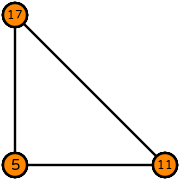an encyclopedia of finite element definitions
Bell
Click here to read what the information on this page means.
| Orders | \(k=5\) |
| Reference elements | triangle |
| Polynomial set | \(\mathcal{Z}^{(4)}_{k}\) ↓ Show polynomial set definitions ↓ |
| DOFs | On each vertex: point evaluations, point evaluations of first derivatives, and point evaluations of second derivatives |
| Number of DOFs | triangle: \(18\) |
| Mapping | identity |
| continuity | Function values and first and second derivatives are continuous. |
| Categories | Scalar-valued elements |
Implementations
"Bell"↓ Show Symfem examples ↓ This implementation is used to compute the examples below and verify other implementations. | |
"Bell"↓ Show (legacy) UFL examples ↓ |
Examples
| triangle order 5 |  (click to view basis functions) |
References
- Bell, Kolbein. A refined triangular plate bending finite element, International Journal for Numerical Methods in Engineering 1(1), 101–122, 1969. [DOI: 10.1002/nme.1620010108] [BibTeX]
DefElement stats
| Element added | 20 February 2021 |
| Element last updated | 20 May 2024 |